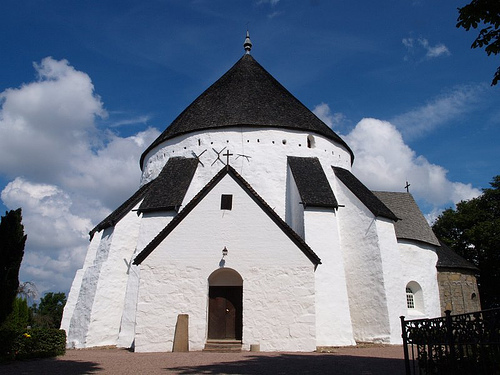

Location: 5 km (3 mi) South of Gudhjem, Bornholm island
Dedicated: St. Laurentius (St. Lawrence, St. Lars)
Osterlars Church is the oldest and largest of the round churches in Denmark is located on the Danish island of Bornholm. Osterlars Church was originally constructed in 1160 it was dedicated to St. Laurentius (St. Lawrence, St. Lars).
This unique and beautiful Osterlars church contains colorful frescoes or kalkmalerier in Dutch that were uncovered and restored in 1889 by Jacob Kornerup. Denmark along with much of the North Europe went along with Reformation of Martin Luther and since he told them icons is a form of idolatry the frescoes were covered by paint as a quicker, cheaper alternative from physically removing it. They depict different scenes from the New Testament from the Bible including Annunciation, Passions of Christ and Judgment Day. The third story of this Romanesque church carries small windows that could be used for shooting arrows in case the parishioners were attacked by the Wends, Swedes or other enemies. Its thick walls would add security to the overall structure. During late medieval times its defense lost much of the original purposes and only few hints exist that it once served as military fortification as well as a house of prayer. Some fans of conspiracy theories proposed the idea that Osterlars Church served some important secret purpose for the Templar's Knights. There is no documentation that can prove any link. If there is any link to Crusades in the Middle East it is link to Church of Holy Sepulcher in Jerusalem that is round.
Inside the Osterlars church you will see a honorary plaque that mentions Rev. Jørgen Jensen Sode and his wife Maren Hansdatter Anker. These two notable citizen lived in the 16th century then the Swedish army took the Island of Bornholm in February 1658. Swedish Commandant Johan Printzenschiöld arrived to the island with his wife and five children. Danish king Frederik III ordered unofficial incentives to start a revolt. It was done secretly because it did not fit the standards of the noble warfare, but it had its results. A small conspiracy of 22 men and brother of Maren Hansdatter Anker, Poul Hansen Anker, came with a plan to murder the Swedish Commandant. On December 8th, 1658 Johan Printzenschiöld was shot on his way to Rønne. This eventually led to liberation of the island.